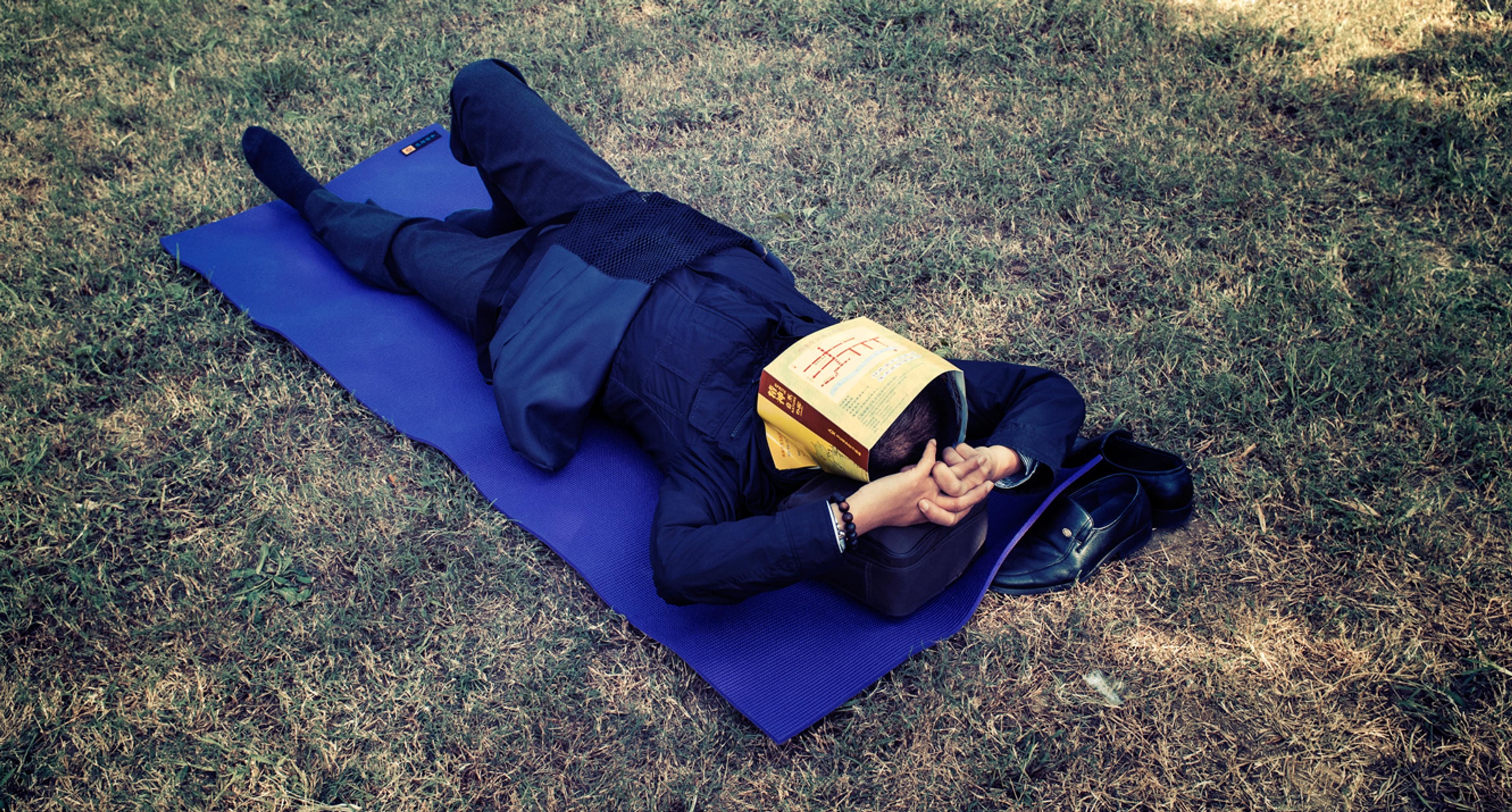Most of us have had a nightmare or a few. They’re a normal response to stress. But for a significant minority of people, they’re so frequent – about 5 per cent of the population experiences nightmares on a weekly basis or worse – that the disruption to sleep can be severely harmful to mental health, increasing symptoms of anxiety, depression and even suicide risk.
People who experience frequent nightmares can feel helpless, doomed to relive disturbing dreams on any given night. Common recurring themes include out-of-control vehicles, falling, being chased or attacked, teeth falling out, and being late or unprepared for an exam. Here’s a typical example:
I was on a bus. I don’t know where we were or where we were going. The sun was moving across the sky way too fast. I tried speaking to the other passengers but none of them seemed able to hear me. I went to speak to the driver but there wasn’t one, the bus was driving itself. It was night-time now and completely dark outside. The bus speeded up and the engine noise made it clear we were going way too fast. The full moon came up and was moving fast across the sky like the sun had done. I tried to alert the other passengers. I tried to access the driver’s compartment but it wouldn’t open. The other passengers just sat there. I began to panic. I woke up still hyperventilating.
– A volunteer’s description of his nightmare, collected as part of a study I conducted with colleagues at Swansea University
For people who experience frequent nightmares, sleep becomes a constant source of fear and restlessness rather than respite. Repeatedly waking from nightmares is a shock to both their body and mind: heart racing, hyperventilating, palms sweating, with emotional distress that can persist well into the day and further disrupt sleep the following night.
I’m a dream scientist. One of the goals of my work is to help nightmare sufferers. I study dreams to better understand how they work, and what happens when dreaming is disrupted, including by the experience of recurring nightmares. I want to uncover ways to repair nightmares and, in their place, engineer dreams for healing.
Over the past decade, I’ve worked in sleep laboratories all around the world. I’ve watched hundreds of people sleep so that I can wake them up to ask them about their dreams. Today, I work at the University of Rochester’s Sleep and Neurophysiology Research Laboratory in New York state, which happens to be where I fell in love with this research field as an undergraduate intern in 2008. That same year, in my dorm-room bed, is when I had my first ever lucid dream – when you know you’re dreaming and you can exert some control over what’s happening. In this lucid dream, I opened my eyes, turned around, and saw that my body was still lying asleep! I was literally beside myself, as I realised I was inside a dream. I remember being amazed at how vivid and real everything looked, and that this alternative reality was being created inside my mind.
When I woke up, I knew that this was what I wanted to study; I wanted to explore the world of dreaming through scientific sleep research. And since beginning my career as a graduate student in the Dream and Nightmare Laboratory in Montreal in 2011, I’ve done just that, studying the science, psychology and practice of dreaming.
Expressions during sleep, such as smiling or laughing, correspond to the emotional content of a person’s dreams
Researchers in my field typically conduct studies in sleep laboratories using polysomnography, which involves measuring a person’s eye movements, brainwaves and heartbeat while they sleep. This approach began in 1951 when the American physiologist and pioneering sleep researcher Eugene Aserinsky placed electrodes on his eight-year-old son’s scalp and around his eyes, and discovered that there were periods of the night where his son’s eyes were moving, which corresponded with changes in brain activity. If awakened during these periods, which are known today as rapid eye movement (REM) sleep, participants are much more likely than at other sleep stages to report vivid sensory, emotional and bizarre dreams (while dreams are more likely to occur, and are more vivid, during REM sleep, it’s not true that they occur only during REM sleep, as used to be believed).
To influence dreams, dream engineers need to understand the processes that shape dream content. For a long while, a conventional view was that dreaming is a simulation of waking life generated purely by brain activity. However, evidence is mounting that the rest of the body also contributes to dream generation, which has huge implications for dream engineers seeking ways to shape dreams.
For instance, consider a recent study of lucid dreamers by the neurologist Isabelle Arnulf and her team at the Pierre and Marie Curie University in Paris. Arnulf and her colleagues asked their lucid dreamers to hold their breath within their dream, and found that, as they did so, there was actually a cessation of airflow in the real sleeping body, as measured by a sensor placed in the nostrils. This provides evidence that, at least in lucid dreamers, the physical body is manifesting dream content in real time. There’s also a correspondence between the body and more emotional dream content. Another of Arnulf’s recent studies suggests that a person’s expressions during sleep, such as whether they are smiling or laughing, correspond to the emotional content of their dreams.
These parallels between the body and dream content can be clinically important. The increased heart and respiration rate that accompanies nightmares or anxious dreams means that individuals who experience frequent nightmares are actually experiencing a frequent excess of physiological arousal during their sleep. The links between our bodies and our dream content also offer a tantalising route towards intervening to change dreams.
Another crucial issue for dream engineers is the function of dreams. Solving this puzzle might offer further clues for how to manipulate dreams therapeutically. One theory is that REM sleep and dreaming help to integrate our recent experiences, especially emotional experiences, into our broader autobiographical memory.
I experienced this aspect of dreams first-hand. When I was a graduate student, I volunteered to be a subject in a dream study led by Elizaveta (Liza) Solomonova, who’s one of my colleagues. Liza placed electrodes on my scalp, face and arms before I took a morning nap in the laboratory bedroom. She then went to the control room to watch my brainwaves on a computer as she waited for me to nod off. When she saw that I was in REM sleep, and even witnessed my eyes moving beneath closed eyelids on the infrared recording displayed on the television above, she woke me up. ‘Michelle?’ she said, using a microphone that broadcast into the bedroom. ‘Can you tell us your dream?’ This was my reply:
Okay. Uh, at the beginning of the dream, I was in bed here and I was trying to fall asleep and a little grey cat came in onto the bed, but actually it was Liza, and Liza was telling me it’s time to get up. And then, uh, I walked out into the lab room actually, following Liza the cat…
It’s quite typical for dreams to incorporate a recent experience – in this case, the experience of being in the laboratory and knowing Liza would wake me up. But dreams are not just a replay of waking life: they are a novel, often bizarre, recreation. While bizarreness might seem random at first, many dream researchers think that it serves a function in forming novel associations between related memory traces. Take the fact that, when I sleep at home, my grey cat wakes me up every single morning by jumping on the bed. My dream thus formed the novel association between my-grey-cat-who-wakes-me-up-at-home and Liza-the-experimenter-who-wakes-me-up-in-the-lab. This process of association might help us to integrate new and salient experiences into our personal life story.
Crucially, in the case of nightmares, it seems that this process is disrupted. With their recurring themes and script-like nature, nightmares are less associative than typical dreams. It’s as if the intense emotion gets in the way of the dream doing its job of making new connections. The script replays, the emotion builds, the awakening disrupts, the cycle repeats.
To break out of this trap, the most common treatment for recurring nightmares is imagery rehearsal therapy, which involves using visualisation while awake to modify a nightmare. A dreamer undertaking this therapy will typically write down their nightmare and attempt to change something about the script to make the dream more positive. Then they’ll spend 10 to 20 minutes mentally rehearsing this reimagined version of their dream.
She was able to choose to engage with the dream in a novel way: to call for help
Returning to my earlier example of the person who had the nightmare involving a speeding, out-of-control bus: he used visualisation to reimagine watching the scene from the sunny sky above. Looking down at the road, he saw that the bus was actually moving incredibly slowly, at a snail’s pace. He realised that the bus hadn’t been out of control at all, but had only seemed to be moving fast because the dream-time had passed over a full day and night. Observing the re-imagined scene with everything slowed down helped him feel much calmer.
Imagery rehearsal is a simple technique that reduces nightmare frequency and severity, and even associated symptoms, such as anxiety and depression. However, other dream-engineering approaches go a step further, attempting to influence dreams as they’re occurring during sleep. One avenue for this is via lucid dreaming, and lucid dreaming therapy is now one of the American Academy of Sleep Medicine’s recommended treatments for nightmares.
Lucid dreaming therapy begins with patients practising a few techniques during the day and just prior to sleep that can increase the likelihood of their having a lucid dream. One technique, ‘reality checking’, involves asking yourself repeatedly throughout the day whether you’re currently dreaming. The idea is for the habit to spill over into sleep where, upon asking yourself the question, you realise that the answer is: ‘Yes, this is a dream!’ Another method, called wake-back-to-bed, involves waking up in the early hours of the morning and staying awake for about 10 minutes, and during that time rehearsing a phrase in mind such as: ‘The next time I’m dreaming, I’ll remember that I’m dreaming.’
Once someone is in a lucid state, the aim of lucid dreaming therapy, similar to imagery rehearsal therapy, is to shift the nightmare script and create a new dream resolution. Here’s an example of a patient with recurring nightmares who went through lucid dreaming therapy: the first recollection is of her recurring nightmare, followed by two subsequent dreams she had over the course of treatment (with key instances of rescripting emboldened):
- He [my ex-husband] chased me again throughout the city in a car. Never mind where I ran, he found me everywhere and grinned sadistically. Shortly before he ran me down with his car, I woke up.
- I dream again that my ex chases me, again by cab … At some point, I was able to simply yell: ‘STOP.’ I woke up.
- I dream that my ex chases me, again by cab. I cried for help. Many people came out of their houses and together we walked towards him. He disappeared.
In the first instance of lucidity, the patient simply realised that she was in the midst of her usual recurring bad dream and decided to wake up. In the next instance, though, rather than just becoming aware of the dream, she was able to choose to engage with the dream in a novel way: to call for help. As soon as the dreamer completed this action, the dream shifted and her nightmare resolved with a more positive ending. In the final dream, she was able to take this positive rescripting even further.
Generally speaking, learning to lucid-dream can increase your sense of agency in dreams and improve attitudes towards sleep and dreams. We’ve also found that, when you wake up from a lucid dream, you actually have a more positive mood in the morning. This is in contrast to the distress that often comes with waking up from a nightmare.
Newer approaches to dream engineering go even further than lucid dreaming therapy in attempting to interact with dreams as they occur. They exploit the fact that the dreaming mind can be thought of as being in a circuitry with the physical body during sleep. This means that we can use the physical body as a permeable barrier to interface with the dreaming mind, for example by applying sensory stimulation to influence subjective experience during sleep.
During my postdoctoral research at Swansea University, my colleagues and I experimented with using this approach to induce lucid dreams. We developed a protocol where, for 20 minutes prior to our volunteers falling asleep, we presented them with a flashing light and a beeping sound at approximate one-minute intervals. Each time they observed these cues, they were instructed to ‘remember to become lucid’. This entailed becoming aware of their thoughts, feelings, sensations, and observing whether the experience was similar to, or different from, normal waking experience. Basically, we were training our volunteers to associate the sensory cues with a lucid mental state.
After the training period, we allowed them to fall asleep and, when they entered REM sleep, we re-presented those same cues as a way to trigger a lucid dream. One volunteer for whom this process worked successfully described the experience like this:
I was shopping in a supermarket and just putting things in my cart and I could hear the beeping. It was like I was getting loads of messages on my phone telling me what to buy, things like ‘Buy some biscuits.’ I only remembered the lights once; there’s clear lights in the shop that flickered.
This volunteer noticed the cues and realised that she was observing them from within the dream state. In another recent study, an international team of experimenters used the same protocol to communicate with dreamers once they became lucid, training them to respond to maths problems with eye signals. For example, the researchers presented the words ‘eight minus six’, and the lucid dreamer responded by looking quickly to the left and right two times. This shows that lucid dreamers can understand speech and respond appropriately. In the future, more complex instructions could be provided, including reminders to rescript a nightmare while it’s occurring.
She pictured the tiger suddenly turning into a childish cartoon and jumping up onto her bed
Another dream-engineering approach that uses spoken prompts to direct dreams is Dormio, a glove-like wearable device that’s designed to detect sleep onset via sensors that measure muscle flexion, heart rate and electrical dermal activity. When it detects sleep onset, Dormio gives an auditory prompt to influence what you dream about in the hypnagogic state – the initial state between wakefulness and sleep-onset, during which people are particularly receptive to suggestion.
In a recent study showing how it might be possible to exploit the hypnagogic state for dream engineering, Adam Haar Horowitz and his colleagues at MIT programmed Dormio to prompt dreamers to ‘think of a tree’ just after they drifted off. Each time the researchers did this, they woke their volunteers and asked them to describe their dream, to see if the prompt had worked. The researchers saw that, over time, with each successive dream incubation, the hypnagogic images started to become more creative and dreamlike:
Awakening 1: Trees, many different kinds, pines, oaks.
Awakening 3: A tree from my childhood, from my backyard. It never asked for anything.
Awakening 5: I’m in the desert, there is a shaman, sitting under the tree with me, he tells me to go to South America…
My colleagues and I have recently started using the hypnagogic state for nightmare rescripting. In one ongoing study, we asked participants to come into the sleep lab for multiple sessions where they listened to a guided meditation designed to induce the sleep onset state and, when they were within that state (which we detected via their brainwaves), we asked them to reimagine a bad dream. For instance, ever since her house had been broken into as a child, one participant had a recurring nightmare of being chased through her house by a tiger. When she reimagined the dream, she pictured the tiger suddenly turning into a childish cartoon and jumping up onto her bed. A week later, she told us that her roommates had remarked that she was going to bed earlier, and she realised that over so many years she’d avoided going to sleep because of this underlying fear around being alone in her bedroom. Changing the nightmare script seemed to immediately shift her attitude towards sleep.
Such results suggest that one day it might be possible to use a Dormio-like device to help people exploit the hypnagogic state and rescript their nightmares within the comfort of their own homes. (Outside of a clinical context, it might also be possible to use such devices to take advantage of the bizarre associative qualities of the hypnagogic state as inspiration for artwork or storytelling.)
Another exciting new dream-engineering device with the potential to treat nightmares is Essence, created by Judith Amores Fernandez at MIT and Harvard Medical School. Amores designed Essence to release different scents via three small canisters, and to be pairable with an app and wearable technology that measures heart rate, respiration rate and possibly brainwaves. One application of Essence would be to release a pleasant scent during REM sleep, particularly in nightmare sufferers. Prior research has shown that exposure to a pleasant scent during sleep actually gives you more positive dreams. So, by exposing someone to a pleasant scent during REM sleep, or even during specific REM periods marked by elevated heart rate and breath rate, it might ameliorate dream emotion and decrease nightmare occurrence. Other similar devices are currently being developed and tested, such as an FDA-approved app, NightWare, that triggers vibrations when it detects increased heart rate during REM sleep, designed to interrupt nightmares. This device is currently being tested in a clinical trial of 240 patients.
It’s such an exciting time to be a dream engineer – the field is moving fast. In the not-too-distant future, I envision a form of dream-interface therapy that combines the different strands of research that I and others are working on. Picture a device that detects the emotional content of your dreams (for instance, by monitoring your bodily arousal and facial expressions), and nudges you to feel calmer, either through scent or sounds, or by instructing you to visualise a previously rescripted dream. You could then report back your success or otherwise using eye movements or other predetermined signals, making tweaks for the next time, as needed.
At a more fundamental level, dream engineering, including the research and technology around lucid dreaming, are bringing the usefulness of dreaming back into our culture. My hope is that not only will problem nightmares soon become far easier to treat, but that we’ll provide ever more fun ways to help everyone make the most of their dreaming lives.
To read more about sleep and dreaming, visit Psyche, a digital magazine from Aeon that illuminates the human condition through psychology, philosophical understanding and the arts.
This Essay was made possible through the support of a grant to Aeon from the John Templeton Foundation. The opinions expressed in this publication are those of the author and do not necessarily reflect the views of the Foundation. Funders to Aeon Magazine are not involved in editorial decision-making.






